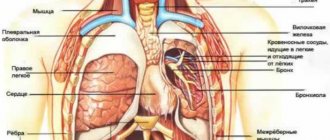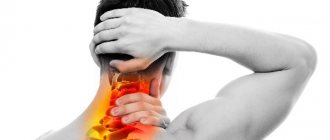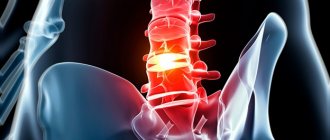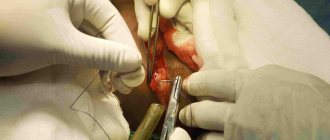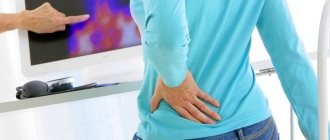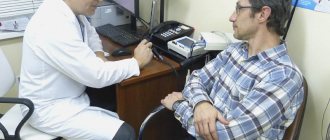Osteochondrosis
is a concept used to designate a group of diseases associated with degenerative and dystrophic changes in the structures of the spine.
First of all, the intervertebral discs suffer, and as the disease progresses, the vertebrae themselves. Degenerative
are changes associated with the processes of tissue wear, aging, loss of original properties, and
dystrophic
are changes caused by tissue nutritional disorders. Thus, the term osteochondrosis unites most non-inflammatory spinal pathologies.
The spine forms the basis of the skeleton, connecting the various parts of the skeletal system. It supports the head, ribs and muscles are attached to it. The spinal cord passes through the spinal column, through which the brain is connected to various parts of our body. Man is the only upright creature in the world, and the spine is designed to ensure upright walking. Therefore, the spinal column has a curved shape, reminiscent of the letter S of the Latin alphabet and is not a rigid rod, but a complex structure consisting of elements fastened together - vertebrae. This structure of the spine allows us to perform various movements, be flexible and absorb shocks and shocks. The function of shock absorbers is performed by intervertebral discs - cartilaginous layers consisting of the nucleus pulposus and the fibrous ring surrounding it. The core takes on the load and absorbs it, and the fibrous ring prevents the core from flattening under pressure.
A decrease in the elasticity of the intervertebral discs can be the beginning of a wide range of problems. Unable to withstand the load, the intervertebral discs begin to deform and the spine loses its correct shape. The progression of the disease leads to further destruction of the intervertebral discs, the fibrous ring is torn, the vertebrae come into rigid contact with each other, and pinching of the nerves connecting the spinal cord with various parts of the body becomes possible. This is how osteochondrosis develops. Intervertebral hernias occur, and inflammation often develops. Deprived of shock absorption, the vertebrae can become flattened, and together their joints form scar and bone growths.
Osteochondrosis is one of the most common diseases. Only cardiovascular diseases are more common. According to some estimates, every second person on the planet suffers from osteochondrosis. Osteochondrosis is more common in women, but in men its manifestations are on average more painful.
Causes of osteochondrosis
The causes of osteochondrosis are quite varied.
Firstly, with age, the elasticity of the intervertebral discs is gradually lost.
This means that our back requires special attention. Prolonged stay in a position that causes spinal misalignment can cause irreversible changes. You should avoid sitting in an asymmetrical position, fight the habit of lying on only one side, and carrying a load (for example, a bag) in only one hand.
A sedentary lifestyle has a detrimental effect on the health of the spine. It is necessary to move, but physical activity should be moderate. The spine should be given the opportunity to recover after stress, and it is also advisable to avoid injuries that also lead to the development of spinal pathologies.
The second group of reasons is associated with metabolic disorders
and
poor nutrition
. Food rich in carbohydrates and fats saturates the body with calories, which we, in our sedentary city life, often simply have nowhere to spend; As a result, energy is stored as fat tissue, creating excess weight. Obesity is an increased load on the spine, which leads to the development of osteochondrosis. In addition, such a diet usually contains insufficient amounts of microelements (calcium, potassium, phosphorus, magnesium, manganese and others), which are so necessary to strengthen bone tissue. Endocrine diseases are often the cause of excess weight. At the same time, a violation of energy, water or mineral metabolism can also negatively affect the tissues involved in the structure of the spine.
Factors contributing to the development of osteochondrosis may be:
- flat feet;
- hormonal changes;
- infectious diseases;
- local circulation disorders,
as well as some other factors.
Stages of the disease
In the development of osteochondrosis, neurologists distinguish 4 stages, which are characterized by various changes in the spine:
- Stage 1 – excessive compression or stretching of the intervertebral disc occurs in the spine, which leads to the onset of pathological changes in the nucleus pulposus and annulus fibrosus;
- Stage 2 – cracks begin to form in the annulus fibrosus. The distance between the vertebrae narrows, which causes the nerve roots to be pinched and inflammation occurs;
- Stage 3 – the vertebrae continue to shift, and the intervertebral discs continue to deteriorate. At this stage, a spinal hernia may occur, which is characterized by the formation of a crack in the membrane of the intervertebral disc and protrusion of the nucleus pulposus;
- Stage 4 – destroyed intervertebral discs are replaced by connective tissue – degenerative restoration of spinal structures.
All changes in osteochondrosis are determined during diagnostic procedures.
Make an appointment
Symptoms of osteochondrosis
At the initial stage of osteochondrosis, there are no pronounced symptoms. The development of osteochondrosis can be assumed in the following cases:
- dull painful sensations in the back (in the affected area of the spine);
- feeling of heaviness in the back, constant tension in the spinal muscles;
- muscle numbness, the appearance of “goosebumps”. In such cases, they usually say that “the back is numb”;
- crunching when turning the body and neck;
- headache, dizziness, tinnitus (typical of cervical osteochondrosis);
- aching pain in the chest area (typical of thoracic osteochondrosis).
At the first appearance of such symptoms, it is advisable to undergo examination by a neurologist.
Further development of the disease manifests itself in symptoms that cause significant discomfort:
Back pain
There is severe pain in the back (along the spine). The pain may radiate to the limbs.
Numb fingers
A typical manifestation of osteochondrosis is numbness of the fingers and toes.
Limitation of physical activity
Even with minimal physical activity, the pain intensifies (for example, as a result of shaking and jolts when traveling in transport). Pain leads to significant limitations in mobility and physical activity.
Treatment
Medicines for spinal osteochondrosis and other treatments are prescribed by a specialist.
Osteochondrosis does not tolerate self-indulgence, and inadequate therapy can lead to disastrous results. Treatment of osteochondrosis includes drug therapy, physiotherapeutic procedures, and physical therapy. Drug treatment has the following goals:
- Relieving inflammation with non-steroidal anti-inflammatory drugs;
- Elimination of pain with non-steroidal anti-inflammatory and analgesic drugs;
- Relieving muscle spasms with muscle relaxants;
- Inhibition of dystrophic processes by chondroprotectors;
- General strengthening of the body with mineral and vitamin complexes.
Physiotherapy for osteochondrosis includes massage, reflexology, methods of hardware physical influence (electrophoresis, ultrasound, laser therapy, magnetic therapy).
Reflexology and massage for spinal osteochondrosis can eliminate muscle spasms and improve blood circulation in the affected area. Hardware methods are also used for this purpose. Drug electrophoresis allows drugs to be delivered through the skin directly to the site of the lesion. Therapeutic exercise helps to normalize spinal mobility, strengthen back muscles and improve overall well-being. An important element of complex therapy for osteochondrosis is diet therapy. The cooks at the Yusupov Hospital include in the diet of patients suffering from osteochondrosis foods that contain sufficient amounts of protein, vitamins and minerals. The dishes contain a small amount of table salt, fats and simple carbohydrates.
Methods for diagnosing osteochondrosis
The main role in the diagnosis of osteochondrosis belongs to instrumental studies: radiography, computed tomography, MRI.
It may be necessary to confirm that the symptoms observed are not caused by other diseases. For the purpose of differential diagnosis, general and biochemical blood tests, general urinalysis, and ultrasound examinations of internal organs are performed.
X-ray of the spine
X-rays of problematic parts of the spine are taken. Which department needs to be examined is determined based on the patient’s complaints.
More information about the diagnostic method
Computed tomography (CT)
Computed tomography (MSCT) makes it possible to obtain a more informative picture of pathological processes and determine the degree of their severity. In particular, MSCT can detect intervertebral hernia.
Computed tomography is performed in cases where radiographic data is insufficient.
More information about the diagnostic method
Magnetic resonance imaging (MRI)
MRI is the most informative method for diagnosing osteochondrosis. In some cases (for example, if osteochondrosis of the thoracic spine is suspected), MRI cannot be avoided. Magnetic resonance imaging allows you to visualize cartilage and soft tissue, based on which you can localize the source of problems as accurately as possible and determine the cause of the disease.
More information about the diagnostic method
Sign up for diagnostics To accurately diagnose the disease, make an appointment with specialists from the Family Doctor network.
Prevention
Since the exact reasons for the development of osteochondrosis are unknown, its prevention consists of general strengthening of the body and a healthy lifestyle.
People who have a hereditary predisposition to the development of osteochondrosis need to especially monitor their health. Osteochondrosis is a disease of a sedentary lifestyle. It can be prevented by performing special gymnastic exercises. They are developed individually for each patient by rehabilitation clinic specialists. When playing sports, you should not overdo it and expose your spine to excessive stress. Physical exercise should be moderate and regular. Good prevention of osteochondrosis is swimming and yoga.
To reduce the risk of disruption of vertebral nutrition and cellular metabolism, doctors recommend giving up bad habits (drinking alcohol and drugs, smoking). You should spend more time in the fresh air, take more walks.
general characteristics
Osteochondrosis is a degenerative disease of the spine, which most often affects the thoracic, lumbar and cervical regions. This pathology has a direct correlation with age. The disease is much more common in people over 40 years of age, but recently there has been a trend towards rejuvenation. Common osteochondrosis differs in that it affects more than one section of a department or several departments at once. Due to the progressive development of degenerative processes not only in bone tissue, but also in the ligamentous apparatus of the spine, the vertebrae become mobile and put pressure on the nerves and blood vessels. The symptoms of common osteochondrosis are associated with this, but it is noteworthy that the disease can be asymptomatic for some time.
Common osteochondrosis is a pathology that affects several areas of one part of the spine or several parts at once.
Important! The pathology requires multidisciplinary control, since it affects not only the musculoskeletal system, but also the nervous system, as well as internal organs. In addition to the spine itself, the pathological process can also affect other elements of the skeleton.
Patient reviews
After being diagnosed with osteochondrosis, many patients do not know where to start. Feedback from people who have encountered a similar situation and found a solution can help in this matter.
Alena M., 39 years old “I have been tormented by pain in the cervical spine since I was young, but I attributed everything to constant overexertion, because I often worked at the computer. But over the past few years, turning my neck has become almost impossible. I first turned to a therapist, who referred me for a consultation with a neurologist. After a comprehensive examination, osteochondrosis was determined. A course of medications was prescribed, anti-inflammatory and to relieve tension. The effect was immediate, but when I went back to the doctor, he said that to consolidate the result and lasting remission, I needed exercise therapy and massage. Now I try to practice every day.”
Tatyana R., 48 years old “Osteochondrosis in the neck is my occupational disease, with which I have been suffering for many years. At first I took courses of medications, but they only blocked the pain and helped for a while. Gradually the attacks returned again, and treatment had to be started all over again. I have now started a course of chondroprotectors, plus I constantly do physical therapy in the gym, and a health worker monitors the entire process to make sure everything is done correctly. I hope for a more lasting result."
Valeria K., 49 years old, “Pharmaceutical patches have helped a lot in coping with pain during an exacerbation of osteochondrosis, but they don’t last long. To make the result more lasting, you need to constantly exercise and adjust your lifestyle. The doctor prescribed dietary supplements to restore cartilage tissue and exercise therapy. When I have time, I try to do the complex, it doesn’t seem difficult and doesn’t take much time, but I often forget to do it. And in this matter, the main thing is regularity to get a lasting result.”
Cervicothoracic osteochondrosis is a chronic degenerative process occurring in the intervertebral disc. It negatively affects the condition of the musculoskeletal system as a whole, and provokes a narrowing of the space between the vertebrae, leading to the proliferation of bone tissue and the appearance of osteophytes. The condition is especially dangerous in cervicothoracic localization, therefore, when the first signs of the disease appear, it is recommended to consult a doctor for comprehensive treatment.
